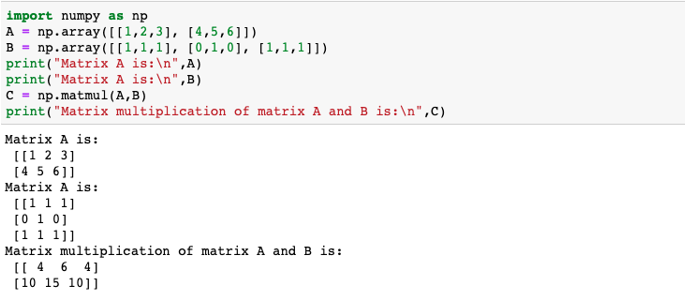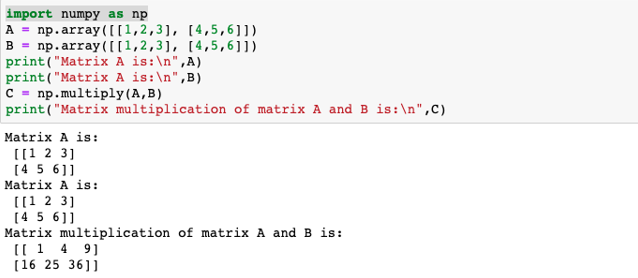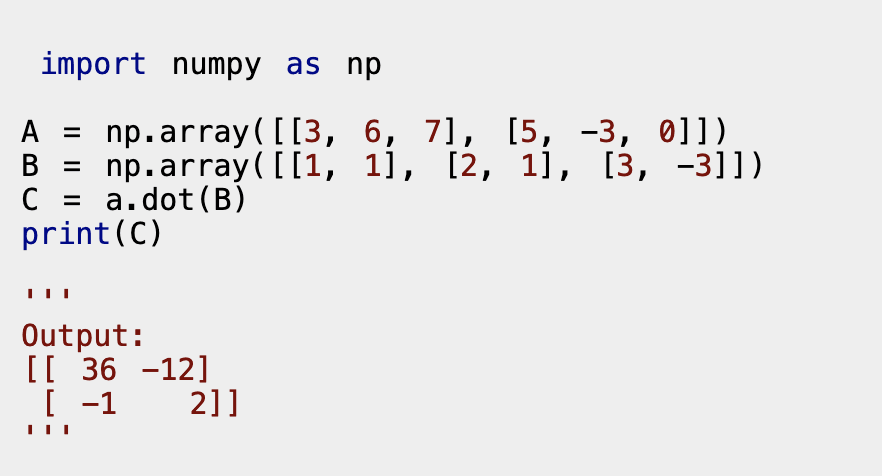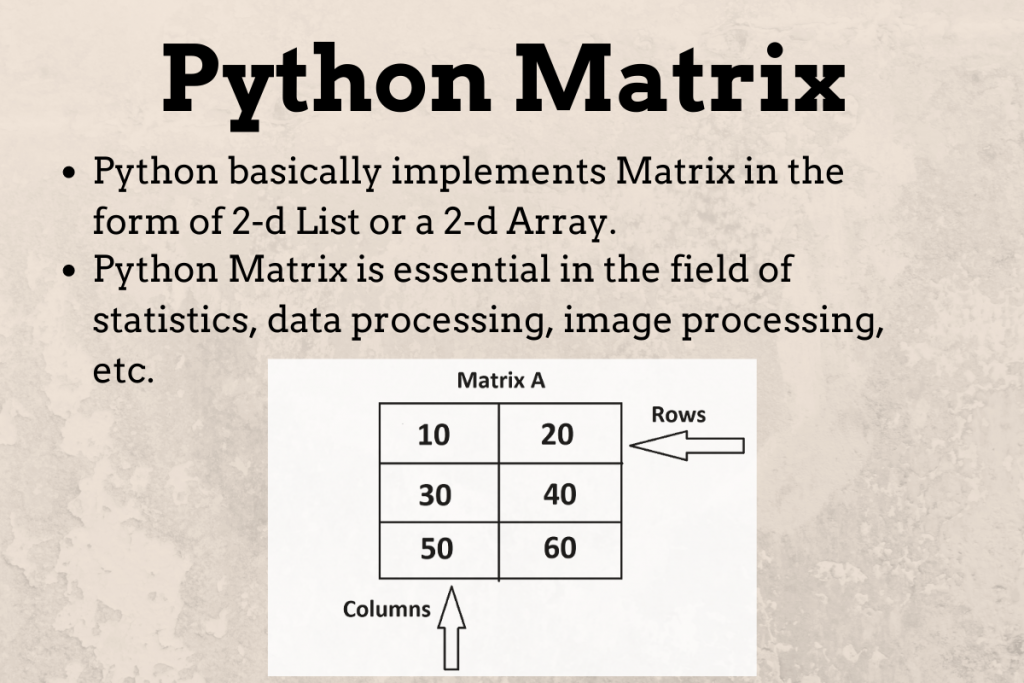Numpy Multiply Array By Transpose
Testmatrix numpyarray 12 34 56 78 prod testmatrix testmatrixT print eig prod I expected to get the following result for the product. Import numpy as np arr2d nparange6 printarr2d printn printAfter applying T.

Multiplying The Matrix Via Its Transpose Using Numpy Stack Overflow
For a 2-D array this is a standard matrix transpose.

Numpy multiply array by transpose. It is the list of numbers denoting the new permutation of axes. Numpytransposea axesNone a It is the array that needs to be transposed. We can use the transpose function to get the transpose of an array.
Multiply x1 x2 outNone whereTrue castingsame_kind orderK dtypeNone subokTrue signature extobj multiply Multiply arguments element-wise. T attribute is exclusive to NumPy arrays that is ndarray only. MT cT array 0 0 0 4 5 6 14 16 18 Solution 2.
Numpymultiply arr1 arr2 outNone whereTrue castingsame_kind orderK dtypeNone subokTrue signature extobj ufunc multiply Parameters. Using npnewaxis import numpy as np. Import numpy as np M1 nparray3 6 9 5 -10 15 4812 M2 M1transpose printM2 Output.
1 2 3 4 5 6 Transposed Array. B nparray 111 010 111 print Matrix A isnA print Matrix A isnB C npmatmul AB print Matrix multiplication of matrix A and B isnC The matrix product of the given arrays is calculated in the following ways. Multiplication with another matrix.
Numpymultiply function is used when we want to compute the multiplication of two array. 1 2 3 4 5 6 7 8 9 1 4 7 2 5 8 3 6 9. Arr2d_transpose arr2dtranspose printarr2d_transpose.
The tuple args and dict kwargs are directly passed on from the original call. Popular Course in this category. Gfg nparray 1 2 3 4 5 6 7 8 9 printgfg end nn printgfgtranspose Output.
Matrixtranspose The function gives back a view of the array with the axes reversed. Transpose a 1D array in NumPy. Python numpy module is mostly used to work with arrays in Python.
Import numpy as np a nparray1 2 3 4 5 6 7 8 9 b nparray10 20 30 printA a printb b printAb npmatmulab Output. Import numpy as np. Notice how the result is a vector of length equal to the rows of the multiplier matrix.
Types is a collection collectionsabcCollection of unique argument types from the original NumPy function call that implement __array_function__. Axes optional It denotes how the axes should be transposed as per the given value. Import numpy as np m nparray123456789 c nparray012 m c array 0 2 6 0 5 12 0 8 18 If you add an axis it will multiply.
To convert a 1-D array into a 2D column vector an additional dimension must be added. Transpose axes Returns a view of the array with axes transposed. Npatleast2daT achieves this as does a npnewaxis.
In this case they are shaped the same because they are actually the same object Heres the example from the video. Thats simply x m m or if you want to assign the value back to m its just m m. If we apply T or transpose to a one-dimensional array then it returns an array equivalent to the original array.
Ini_array1 nparray 1 2 3 2 4 5 1 2 3 ini_array2 nparray 0 2 3 printinitial array strini_array1 result ini_array1 ini_array2 npnewaxis printNew resulting array. The effect is seen on multi-dimensional arrays. Numpy Transpose takes a numpy array as input and transposes the numpy array.
For a 1-D array this has no effect as a transposed vector is simply the same vector. 5 11 17 23 11 25 39 53 17 39 61 83 23 53 83 113. To transpose an array or matrix in NumPy we have to use the T attribute that stores the transposed array or matrix.
It returns the product of arr1 and arr2 element-wise. I tried to find the eigenvalues of a matrix multiplied by its transpose but I couldnt do it using numpy. This works because its an element-wise multiplication between two identically-shaped matrices.
M c npnewaxis array 0 0 0 4 5 6 14 16 18 You could also transpose twice. This has no effect on the one-dimensional array as the resultant array is exactly the same. Array_like or scalar1st Input array.
The transpose function from Numpy can be used to calculate the transpose of a matrix. Arr2d_T arr2dT printarr2d_T printn printAfter applying transpose function. Import numpy as np arr1 nparray 1 2 3 4 5 6 print fOriginal Arraynarr1 arr1_transpose arr1transpose print fTransposed Arraynarr1_transpose Output.
Input arrays to be multiplied. The transpose of a matrix is calculated by changing the rows as columns and columns as rows. 1 4 2 5 3.
If you add an axis it will multiply the way you want. Parameters x1 x2 array_like. An example of the application of Numpy matrix is given below.
In this example we can see that its really easy to transpose an array with just one line. As a convenience for __array_function__ implementors. This attribute is invalid for Python lists.
Func is an arbitrary callable exposed by NumPys public API which was called in the form funcargs kwargs.

Element Wise Operations Multiplication Transpose Julienbeaulieu

Numpy Matrix Multiplication Journaldev

Numpy Matrix Transpose Transpose Of An Array In Python Journaldev

Numpy Matrix Transpose Transpose Of An Array In Python Journaldev
Code Tinkering Python Numpy Extension

Matrix Multiplication In Numpy Different Types Of Matrix Multiplication

Numpy Scipy Python Tutorial Documentation

Python Matrix Transpose Multiplication Numpy Arrays Examples

Matrix Multiplication In Numpy Different Types Of Matrix Multiplication

Numpy Matrix Multiplication Javatpoint

Numpy Broadcast Multiplication Over One Common Axis Of Two 2d Arrays Stack Overflow

Numpy Matrix Multiplication Journaldev

Python Matrix Transpose Multiplication Numpy Arrays Examples

How To Implement The General Array Broadcasting Method From Numpy Mathematica Stack Exchange

Python Tutorial Transpose Matrix Transpose A Matrix In Single Line In Python By Microsoft Award Mvp Learn Python Python Programming Learn In 30sec Wikitechy

Pandas Dataframe Transpose How To Transpose Matrix In Python

Rotate A Matrix By 90 Degree Without Using Any Extra Space Set 2 Geeksforgeeks

Numpy Matrix Multiplication Numpy V1 17 Manual Updated
